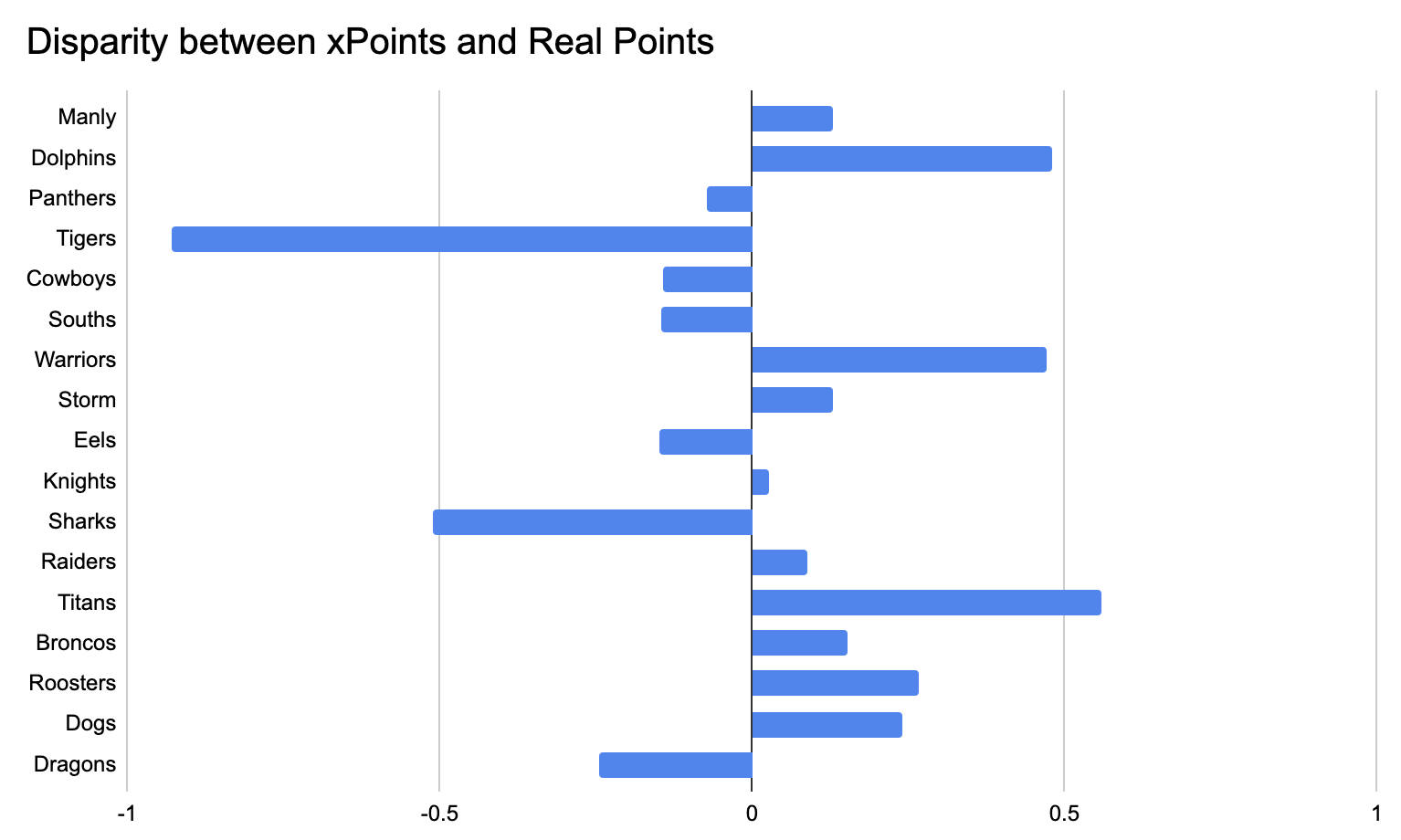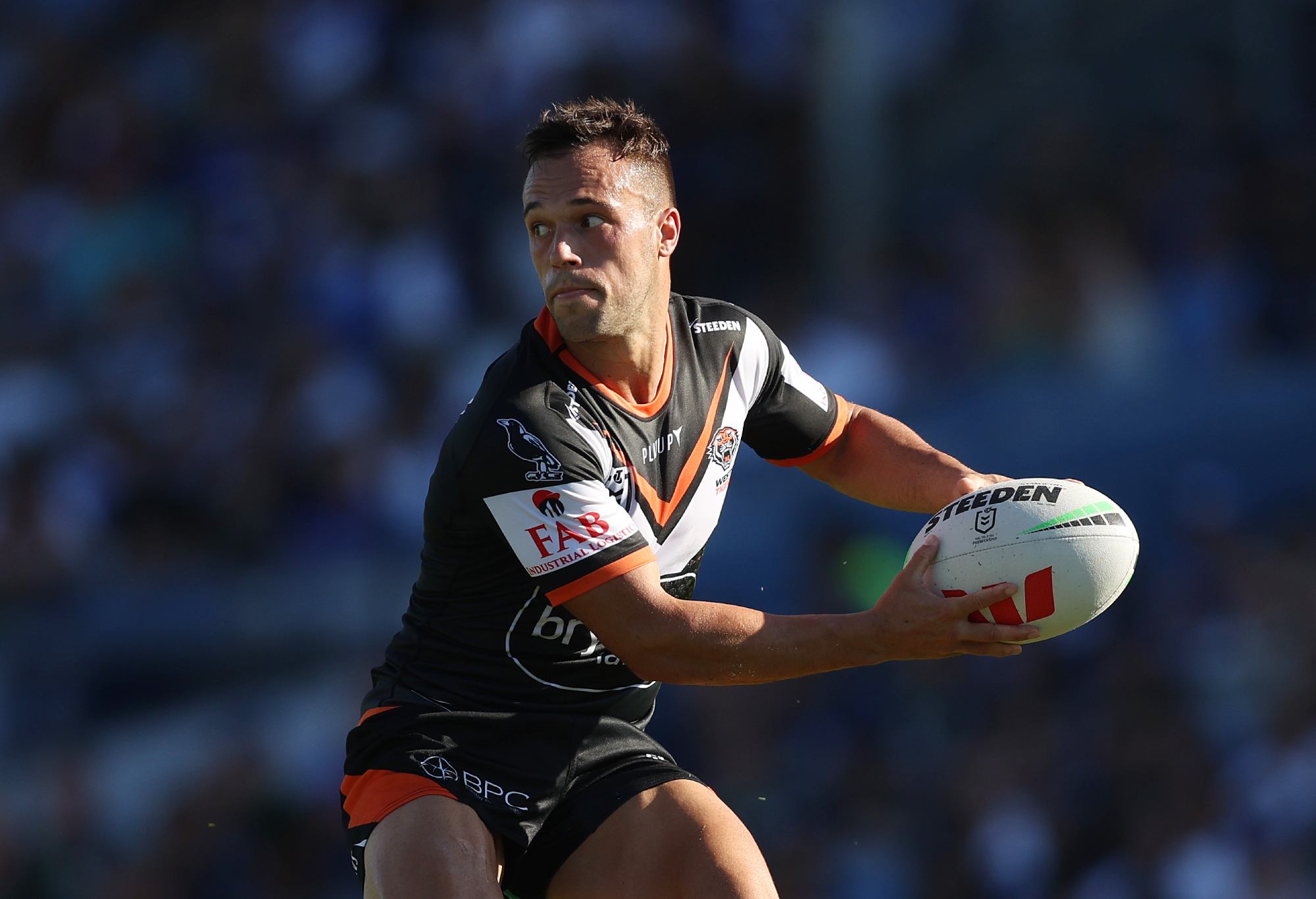The numbers told a strange story for the Wests Tigers in Easter Monday’s defeat to Parramatta.
They won the metre count, by a distance, dominated the ball and the field position and made more line breaks. The only category they lost was the scoreboard.
Eels coach Brad Arthur said as much in the post-match presser, telling the media that his team had got the two points, no injuries, no suspensions and basically no other positives from the game. His side had been battered.
The difference was simple, really. There was a higher level of execution on display from the Eels, which was there for all to see with four try assists from Mitchell Moses, three of which came from his boot.
The Wests Tigers have been kicked from pillar to post, and having started the year 0-6, that might be fair enough. At times, they’ve been a rabble. But in general, they’ve been a lot better than 0-6 looks.
Coach Tim Sheens also semi-admitted this in his presser, mentioning how well his team had performed in second halves while adding that they’d also often given themselves plenty to do by losing first halves.
It’s easier, obviously, to win the second half when the other team knows they’ve won the game.
In games against the Broncos and Bulldogs this year, that dynamic was certainly at play. But it’s far from true overall for the Tigers. Statistically speaking, they’re a perfectly normal football team and, indeed, a better one than last year. The wins column says zero, but it is the only one that does.
It really doesn’t matter that much how you chop the data: they’re doing all the things you might expected of a winning team, except winning.
This is born out in the underlying metrics, which have the Tigers right in the middle of the pack. Nobody is saying they should be leading, but they should be nowhere near the bottom.
We can display this via the xLadder, a statistical model developed specifically to show who is doing well on a performance level, independent of whether they are doing well on the actual NRL ladder.
There’s a full guide here, but here’s a quick recap.
The xLadder uses key indicators of performance – run metres, line breaks, field position and possession – to give a read on who, statistically at least, should have won a game of footy. That’s the underlying data, the building blocks of wins.

Tim Sheens. (Photo by Mark Evans/Getty Images)
The model takes each category as a differential, with a winner and a loser, and is then weighted to reward the stats that are most heavily correlated with winning.
You can break each contest down to the bare bones of who ‘should’, in the data, have won, with the intention of working out how much a team’s form is due to sustainable, repeatable factors and how much is skewed with luck, execution, refereeing or any of the other types of variance that can affect who actually wins the game.

So: how good are the Tigers?
According to the numbers, Wests are worth 5.58 xPoints or (given that some teams have had byes) around 0.93 xPoints per game. Bearing in mind that their real points is zero, that’s a huge disparity.
The graph above displays underperformance of stats to the left and overperformance to the right, with the Tigers close to a point per game down on where they should be, which the model thinks is highly unsustainable and liable to regress. As you can see, the Titans, Dolphins and Warriors might be in for the opposite treatment.
The Warriors provide an interesting case study. They and the Tigers have played six games and no byes, and both are not expected to do well in 2023, just merely to do better than 2022.
New Zealand are 4-2 and would be widely considered to have performed well, even though their actual production metrics are very similar to those of the Tigers. They’ve jagged three wins through better finishing and a spot of positive variance. Amazingly, results tend to colour whether people think you’ve played well or not.

These are the two areas in which the xLadder seeks to add depth: execution and luck.
Friend of the column League Eye Test runs a similar model around who should have scored, called xPoints, which uses field position data to suggest how many points a certain amount of good ball should have been worth to a side.
His model had the score from Easter Monday at 24-10 to the Tigers and the xLadder had them at an 84% winning percentage – either way the Tigers ‘should’ have won.
According to the model, Parra had the most statistically unlikely win in the full sample size of over 250 NRL and Super League games, with the next closest being the Dragons’ 2022 ANZAC Day boilover against the Roosters.
You might suggest here that this is the Tigers’ lack of attack – and they have scored the fewest points in the league, despite multiple teams having played a game more – but the data, again would disagree.
The obvious comparison for a team that gets a lot of ball and territory but doesn’t score any points would be the Bulldogs of the Dean Pay/Trent Barrett era, but that doesn’t work for the Tigers: they have plenty of attack, or at least, they are trying plenty of it. It’s just not coming off.
A better comparison might be last year’s Souths team. They, too, were liable to make a lot of errors – the Tigers currently make the most in the comp – and play expansively for little reward, until it kicked into gear late in the season. They were the darlings of the xLadder model, which always rated their performances well before the results matched them.
The indicators of this for Wests are there. They attempt plenty of shift plays, the most in the NRL, but aren’t going side to side with it, as they also have the highest amount of line engaged runs, and they’re not telegraphing their attack, as they are top for decoy runs.
It’s paying off, too, up to a point. Their line breaks record is far from the worst, but their conversion rate of line breaks into tries absolutely is. This is a side that should have scored a lot more points than it has.
Execution is a strange beast, because sometimes it just clicks. So many factors – whether a pass goes to hand, whether a kick gets a good bounce – are informed by luck, which is random, and confidence, which comes from doing well.
Wests are currently playing like a team who think they can’t score, until they do, at which point the tries come in avalanches. 2005 it might not be, but the data suggests that a good attacking side is in there somewhere.
The Tigers currently have a completion rate of 72% – joint last with Souths – and while that stat is usually not particularly useful, there is a floor of around 73% beneath which it becomes very difficult to win. Knock it up by even a small increment and it would be reasonable to expect the tries to follow.
This is a side that is doing the right things, but not getting the right results. It’s the sort of trend that you would certainly expect to regress over time, which brings us to the next aspect: the Tigers are really unlucky.
Attacking kicks, for example, are an area where teams try to generate variance. They get to the last, then having failed to score across five plays, bomb or grubber in an attempt to either score, induce an error or otherwise force a repeat.
It’s a good test case for how lucky an attack is, and on that metric, the Tigers are very unlucky: they’ve forced a single try off a kick – Brandon Wakeham’s bomb for Isaiah Papali’i last week in Brisbane.
But they’ve also force the second most dropouts and the third most grubbers in goal, with among the fewest bombs. This is a side with a plan that currently isn’t working, but might reasonably be expected to do so in the future.

Luke Brooks. (Photo by Mark Metcalfe/Getty Images)
This is also shown in the number of kick tries conceded, which might reasonably be expected to decrease over time given the glut that has gone against in recent weeks. Mitch Moses and Adam Reynolds, who they have faced in successive weeks, are experts and most teams don’t have someone as good as them.
The Tigers average 26.6 points against per game, which is, obviously, bad and speaks to a few issues that Sheens has been culpable for and can change quickly.
The outside backs and edges, the blokes tasked with finishing the moves and stopping the tries out wide, have been shuffled endlessly.
Of the back five that played against Parramatta, only Charlie Staines and Asu Kepaoa have featured in all six games and – hat tip to Andrew Voss for the stat – Kepaoa has played left and right centre, left and right back row, wing and off the bench in six appearances.
Tommy Talau got two games then departed, while Brent Naden, David Nofoaluma and Starford To’a have had three each. Some of that is injury-enforced, but plenty wasn’t. Pick and stick would do wonders for cohesion and execution on both sides of the ball.
The spine is no better. Sheens has already swapped it about completely, bringing in then discarding Brandon Wakeham, banishing Daine Laurie to reserve grade and not settling on a fullback.
Moving key position players inherently reduces cohesion, which in turn has a knock-on effect – pun vaguely intended – for execution. Again, it’s time to pick and stick. With Adam Doueihi now having suffered a season-ending injury his hand might be forced anyway.
The easiest answer in the world for a coach is to change the personnel when the results are bad, as much as the easy answer for upper management is to change the coach.
The results say 0-6, but the performances say better than that. Their next block after this weekend’s bye goes Manly, Penrith, Dragons, Souths, Cowboys. There are wins there to be found, but they won’t come if there’s no consistency.
For the club that has induced chaos into every possible situation, it’s time to embrace calm. It’s not actually going that badly. The luck will change.
































































































